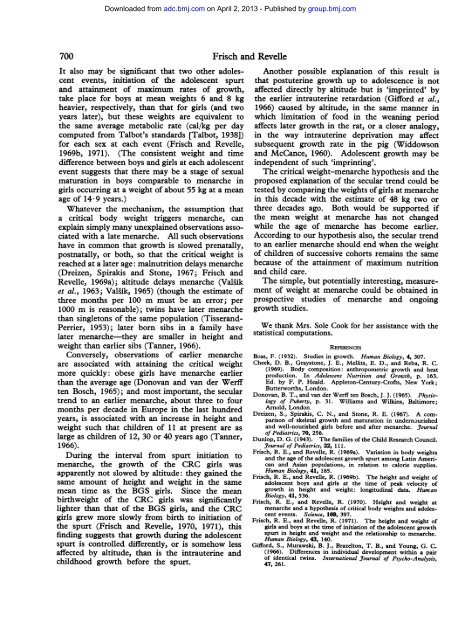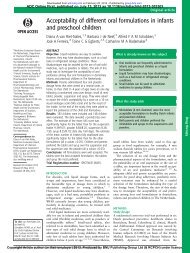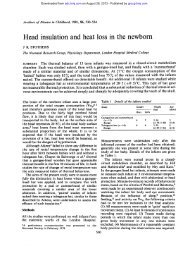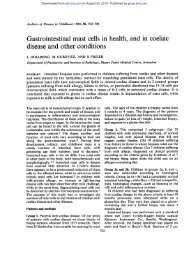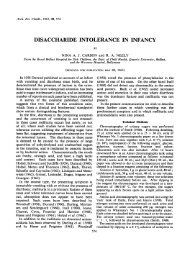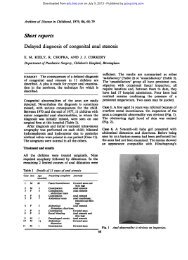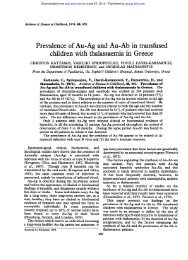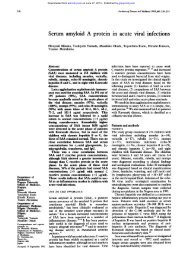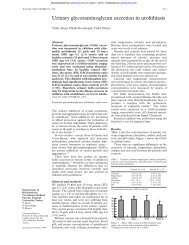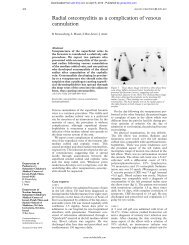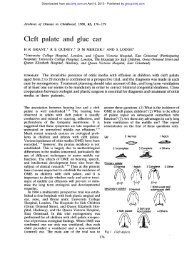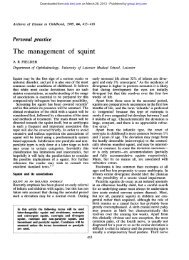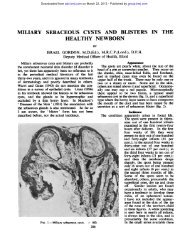Hypothesis of Menarche - Archives of Disease in Childhood
Hypothesis of Menarche - Archives of Disease in Childhood
Hypothesis of Menarche - Archives of Disease in Childhood
Create successful ePaper yourself
Turn your PDF publications into a flip-book with our unique Google optimized e-Paper software.
Downloaded from<br />
adc.bmj.com on April 2, 2013 - Published by group.bmj.com<br />
700 Frisch and Revelle<br />
It also may be significant that two other adolescent<br />
events, <strong>in</strong>itiation <strong>of</strong> the adolescent spurt<br />
and atta<strong>in</strong>ment <strong>of</strong> maximum rates <strong>of</strong> growth,<br />
take place for boys at mean weights 6 and 8 kg<br />
heavier, respectively, than that for girls (and two<br />
years later), but these weights are equivalent to<br />
the same average metabolic rate (cal/kg per day<br />
computed from Talbot's standards [Talbot, 1938])<br />
for each sex at each event (Frisch and Revelle,<br />
1969b, 1971). (The consistent weight and time<br />
difference between boys and girls at each adolescent<br />
event suggests that there may be a stage <strong>of</strong> sexual<br />
maturation <strong>in</strong> boys comparable to menarche <strong>in</strong><br />
girls occurr<strong>in</strong>g at a weight <strong>of</strong> about 55 kg at a mean<br />
age <strong>of</strong> 14 9 years.)<br />
Whatever the mechanism, the assumption that<br />
a critical body weight triggers menarche, can<br />
expla<strong>in</strong> simply many unexpla<strong>in</strong>ed observations associated<br />
with a late menarche. All such observations<br />
have <strong>in</strong> common that growth is slowed prenatally,<br />
postnatally, or both, so that the critical weight is<br />
reached at a later age: malnutrition delays menarche<br />
(Dreizen, Spirakis and Stone, 1967; Frisch and<br />
Revelle, 1969a); altitude delays menarche (Valsik<br />
et al., 1963; Valsik, 1965) (though the estimate <strong>of</strong><br />
three months per 100 m must be an error; per<br />
1000 m is reasonable); tw<strong>in</strong>s have later menarche<br />
than s<strong>in</strong>gletons <strong>of</strong> the same population (Tisserand-<br />
Perrier, 1953); later born sibs <strong>in</strong> a family have<br />
later menarche-they are smaller <strong>in</strong> height and<br />
weight than earlier sibs (Tanner, 1966).<br />
Conversely, observations <strong>of</strong> earlier menarche<br />
are associated with atta<strong>in</strong><strong>in</strong>g the critical weight<br />
more quickly: obese girls have menarche earlier<br />
than the average age (Donovan and van der Werff<br />
ten Bosch, 1965); and most important, the secular<br />
trend to an earlier menarche, about three to four<br />
months per decade <strong>in</strong> Europe <strong>in</strong> the last hundred<br />
years, is associated with an <strong>in</strong>crease <strong>in</strong> height and<br />
weight such that children <strong>of</strong> 11 at present are as<br />
large as children <strong>of</strong> 12, 30 or 40 years ago (Tanner,<br />
1966).<br />
Dur<strong>in</strong>g the <strong>in</strong>terval from spurt <strong>in</strong>itiation to<br />
menarche, the growth <strong>of</strong> the CRC girls was<br />
apparently not slowed by altitude: they ga<strong>in</strong>ed the<br />
same amount <strong>of</strong> height and weight <strong>in</strong> the same<br />
mean time as the BGS girls. S<strong>in</strong>ce the mean<br />
birthweight <strong>of</strong> the CRC girls was significantly<br />
lighter than that <strong>of</strong> the BGS girls, and the CRC<br />
girls grew more slowly from birth to <strong>in</strong>itiation <strong>of</strong><br />
the spurt (Frisch and Revelle, 1970, 1971), this<br />
f<strong>in</strong>d<strong>in</strong>g suggests that growth dur<strong>in</strong>g the adolescent<br />
spurt is controlled differently, or is somehow less<br />
affected by altitude, than is the <strong>in</strong>trauter<strong>in</strong>e and<br />
childhood growth before the spurt.<br />
Another possible explanation <strong>of</strong> this result is<br />
that postuter<strong>in</strong>e growth up to adolescence is not<br />
affected directly by altitude but is 'impr<strong>in</strong>ted' by<br />
the earlier <strong>in</strong>trauter<strong>in</strong>e retardation (Gifford et al.,<br />
1966) caused by altitude, <strong>in</strong> the same manner <strong>in</strong><br />
which limitation <strong>of</strong> food <strong>in</strong> the wean<strong>in</strong>g period<br />
affects later growth <strong>in</strong> the rat, or a closer analogy,<br />
<strong>in</strong> the way <strong>in</strong>trauter<strong>in</strong>e deprivation may affect<br />
subsequent growth rate <strong>in</strong> the pig (Widdowson<br />
and McCance, 1960). Adolescent growth may be<br />
<strong>in</strong>dependent <strong>of</strong> such 'impr<strong>in</strong>t<strong>in</strong>g'.<br />
The critical weight-menarche hypothesis and the<br />
proposed explanation <strong>of</strong> the secular trend could be<br />
tested by compar<strong>in</strong>g the weights <strong>of</strong> girls at menarche<br />
<strong>in</strong> this decade with the estimate <strong>of</strong> 48 kg two or<br />
three decades ago. Both would be supported if<br />
the mean weight at menarche has not changed<br />
while the age <strong>of</strong> menarche has become earlier.<br />
Accord<strong>in</strong>g to our hypothesis also, the secular trend<br />
to an earlier menarche should end when the weight<br />
<strong>of</strong> children <strong>of</strong> successive cohorts rema<strong>in</strong>s the same<br />
because <strong>of</strong> the atta<strong>in</strong>ment <strong>of</strong> maximum nutrition<br />
and child care.<br />
The simple, but potentially <strong>in</strong>terest<strong>in</strong>g, measurement<br />
<strong>of</strong> weight at menarche could be obta<strong>in</strong>ed <strong>in</strong><br />
prospective studies <strong>of</strong> menarche and ongo<strong>in</strong>g<br />
growth studies.<br />
We thank Mrs. Sole Cook for her assistance with the<br />
statistical computations.<br />
REFERENCES<br />
Boas, F. (1932). Studies <strong>in</strong> growth. Human Biology, 4, 307.<br />
Cheek, D. B., Graystone, J. E., Mellits, E. D., and Reba, R. C.<br />
(1969). Body composition: anthropometric growth and heat<br />
production. In Adolescent Nutrition and Growth, p. 163.<br />
Ed. by F. P. Heald. Appleton-Century-Cr<strong>of</strong>ts, New York;<br />
Butterworths, London.<br />
Donovan, B. T., and van der Werff ten Bosch, J. J. (1965). Physiology<br />
<strong>of</strong> Puberty, p. 31. Williams and Wilk<strong>in</strong>s, Baltimore;<br />
Arnold, London.<br />
Dreizen, S., Spirakis, C. N., and Stone, R. E. (1967). A comparison<br />
<strong>of</strong> skeletal growth and maturation <strong>in</strong> undernourished<br />
and well-nourished girls before and after menarche. Journal<br />
<strong>of</strong> Pediatrics, 70, 256.<br />
Dunlop, D. G. (1943). The families <strong>of</strong> the Child Research Council.<br />
Journal <strong>of</strong> Pediatrics, 22, 111.<br />
Frisch, R. E., and Revelle, R. (1969a). Variation <strong>in</strong> body weights<br />
and the age <strong>of</strong> the adolescent growth spurt among Lat<strong>in</strong> American<br />
and Asian populations, <strong>in</strong> relation to calorie supplies.<br />
Human Biology, 41, 185.<br />
Frisch, R. E., and Revelle, R. (1969b). The height and weight <strong>of</strong><br />
adolescent boys and girls at the time <strong>of</strong> peak velocity <strong>of</strong><br />
growth <strong>in</strong> height and weight: longitud<strong>in</strong>al data. Human<br />
Biology, 41, 536.<br />
Frisch, R. E., and Revelle, R. (1970). Height and weight at<br />
menarche and a hypothesis <strong>of</strong> critical body weights and adolescent<br />
events. Science, 169, 397.<br />
Frisch, R. E., and Revelle, R. (1971). The height and weight <strong>of</strong><br />
girls and boys at the time <strong>of</strong> <strong>in</strong>itiation <strong>of</strong> the adolescent growth<br />
spurt <strong>in</strong> height and weight and the relationship to menarche.<br />
Human Biology, 43, 140.<br />
Gifford, S., Murawski, B. J., Brazelton, T. B., and Young, G. C.<br />
(1966). Differences <strong>in</strong> <strong>in</strong>dividual development with<strong>in</strong> a pair<br />
<strong>of</strong> identical tw<strong>in</strong>s. International Journal <strong>of</strong> Psycho-Analysis,<br />
47, 261.


